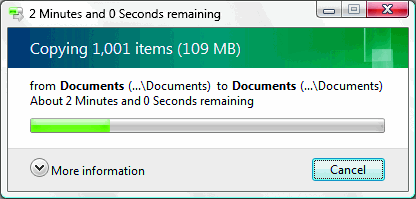SCENARIO
I manage and organize many files during the day, the SendTo is the most used feature that I use on Windows.
PROBLEM
By default, when the user clicks an item/link of the contextmenu to send the files, the O.S does not show any kind of advise/notifier indicating that the files are copying to the selected destination.
I consider it a very wrong design issue because for big files its OK ...a progressbar will be shown, but if the files are to small it will not show any progressbar/visual indicator so is not possible to ensure that the files are copied (without manual effort) because I'm human and I could click outside the SendTo contextmenu by error.
So, I would like to develop a personal mini-tool that will help me to optimize my time showing me a notifier window wherever on the screen when I send/copy files using the SendTo feature from the contextmenu, and only the SendTo feature.
QUESTION
In just simple words, I want to detect a copy/send operation from SendTo menu to ensure that the click was done properly on the menu item (and not outside the menu), by also providing additional basic info such as the source folder, the destination folder, and the amount of files or the filepaths.
Any ideas to start developing this tool in the right direction?.
I will be grateful for a code example in C# or else VB.Net, preferably this last.
APPROACH
Since I don't know how to start doing this I mean which could be the easiest or the efficient way to intercept those SendTo calls, firstly I thought to hook the CopyFile or CopyFileEx API functions, but they do not provide the information that I need because that function will be called in any kind of copy operation and not only when I use the SendTo Feature, so I'm lost.
I'm not sure if I should investigate more about internal calls, or maybe investigate more about the windows contextmenu itself instead of messing with function hooks and ugly things that I could avoid.
My main idea is to develop a hidden WinForms (or else a windows service) that stays in background waiting for when I use the SendTo feature (when I click on an item of the SendTo menu) and then show any kind of visual indicator on the screen to ensure that I properly clicked that menu-item and maybe inform about the amount of files that I'm moving and where I'm moving them.
RESEARCH
Here is a code example that I think it demostrates how to instantiate the SendTo com object to create your own?, but its written in c++ and I'm not sure if the example is helpful because my intention is not to replace the SendTo menu but I'll keep this useful info here it it serves for something else:
How to add(enable) standard "Send To" context menu option in a namespace extension
The KNOWNFOLDERID constants docs gives some useful info about the SendTo folder, again I'm not sure if this could help maybe for a read/access monitoring approach?, I just keep the info here:
GUID: {8983036C-27C0-404B-8F08-102D10DCFD74}
Default Path: %APPDATA%\Microsoft\Windows\SendTo
Legacy Default Path: %USERPROFILE%\SendTo
In the Shell Extension Handlers docs there is a Copy hook handler which I don't know if it has relation with the SendTo's COM component and if that could help me in some way, the same ignorance for IContextMenu::InvokeCommand method reference which maybe I could intercept it to identify a SendTo invocation?
By the moment I feel like flying blind.
I recently found this A managed "Send To" menu class but again its a example written in C/C++ (I think is the same source before) which I don't understand at all and again I'm not sure if that could help me because I repeat that replacing SendTo is not what I have in mind (just because I don't know how to properly do it avoiding all possible risks, I prefer to still let Windows logic copy/send the files, I just want to detect the copy operation to retrieve info)
EXPECTED RESULTS AND USAGE
Step 1:
Select a random file and use the SendTo menu (in my language, Spanish, the command name is 'Enviar a')

Step 2:
Let the .net application's logic (working in background) intercept the SendTo operation to retrieve info.
(I only need help with this step)
Step 3:
Display the info somewhere over the screen to ensure that the SendTo operation was performed, to ensure that I properly clicked the SendTo item (My Link).

(That popup is just a simulation, I don't know any way to retrieve all that info)


SharpShellbut as you've seen I totally want to prevent errors, then I don't want to replace windows copy logic for my own copy logic. I would like to find a less intrusive approach than fully replacing that windows feature. Thankyou anyways! – ProductThen write a shell extension that just instantiates the Microsoft SendTo Servicein case of that will have no-risk then it seems a very good approach!, could you please explain in more detail how to start doing it? I just did simple shell extensions in the past (to catch multiple selected files on explorer), implementing what you said in a shell extension is a little big problem to me without providing a brief example, anyways I'll investigate about it. thanks. – ProductSendToExcommand to replace the originalSendTobut WITHOUT replacing the copy/send logic that uses the originalSendTo, just letting the originalSendToCOM to do the hard job and I keep just suscribed to the original "command" getting the basic info to display it on the screen, then that could be just perfect, but I'm just dreaming. – ProductIFileOperationProgressSinkto report progress. – Didst